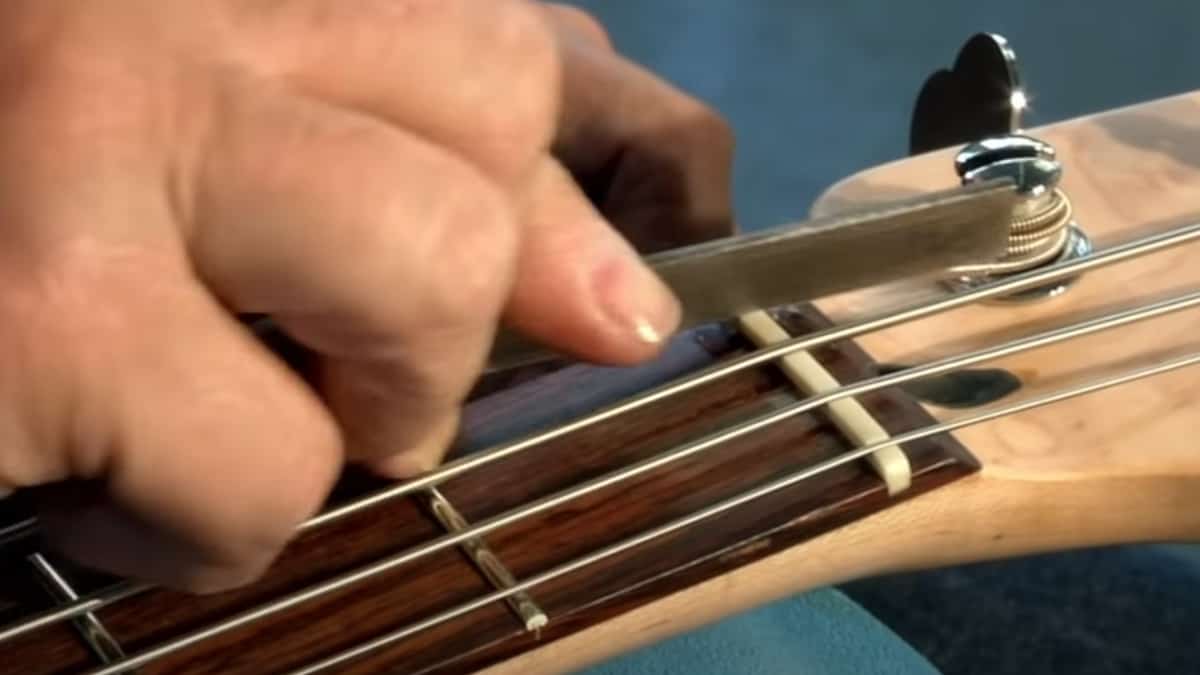The nut on a bass guitar is located at the end of the fretboard, where the headstock begins. It is the small strip that the strings rest on before they reach the tuning pegs.
In the meantime, don't forget to unlock a world of unlimited sound with Amazon Music Unlimited, where over 100 million songs wait at your fingertips. Whether you're working, relaxing, or fueling your creativity, the right track is always just one tap away. Elevate every moment with music that moves you.
The nut of a bass guitar plays a crucial role in defining the instrument’s playability and tone. It maintains the strings at the proper height above the frets, ensuring clear notes and comfortable action. The material of the nut, which can vary from bone to plastic or even synthetic composites, subtly influences the resonance and sustain of the bass.
Essential for both tuning stability and consistent spacing, the nut’s precise positioning and quality can have a significant impact on the instrument’s overall performance. Keeping the nut in good condition is vital for any bassist looking to achieve a clean, buzz-free sound across all frets.
Understanding The Bass Guitar
Embarking on a musical journey with the bass guitar reveals a unique world rich with rhythmic pulses and deep grooves. The bass is the heartbeat of music, providing the foundational low-end that guides the harmony. Recognizing the components that make up this remarkable instrument is essential for both playing and maintenance. Each part plays a pivotal role in sound production and playability, including a small but crucial piece known as the nut.
Anatomy Of A Bass Guitar
The bass guitar is a complex instrument, with each component carefully designed to ensure the perfect blend of tone, sustain, and playability. From headstock to body, here’s a quick rundown of its anatomy:
- Headstock: The top section, which holds the tuning machines.
- Tuning Machines: The gears that tighten or loosen the strings to achieve the desired pitch.
- Nut: A small strip located at the intersection of the headstock and neck, which guides the strings onto the fretboard.
- Neck: The long, thin part of the bass where the fretboard is attached.
- Fretboard: Also known as the fingerboard, it hosts the frets—metal strips dividing the neck into musical notes.
- Frets: The raised elements on the fretboard that help create different pitches.
- Body: The large, main part of the bass that houses the pickups and electronics.
- Pickups: Magnetic coils that capture string vibrations and convert them into electrical signals.
- Bridge: The anchor point for the strings on the body of the bass.
Each part works harmoniously to manifest the signature bass sound.
The Purpose Of The Nut In Stringed Instruments
The nut may be small, yet it holds a significant place in a bass guitar’s functionality. Positioned at the juncture where the headstock meets the fretboard, the nut serves multiple purposes:
- Secures the strings in place, ensuring they align correctly across the fretboard.
- Defines the spacing between strings to facilitate comfortable and accurate finger placement.
- Helps to maintain the strings at the proper height above the frets, influencing the action of the instrument.
- Contributes to the overall tone by affecting the vibration length of the strings.
The role of the nut is vital in preventing buzzing sounds and providing a clear, resonant tone when the strings are plucked or strummed.
Materials Used In Nut Construction
The choice of material for the nut can influence both the tonal quality and durability of the bass guitar. Common materials include:
| Material | Tonal Characteristics | Durability |
|---|---|---|
| Plastic | Decent sustain, brighter tone | Less durable, prone to wear |
| Bone | Rich sustain, warm tone | Highly durable, traditional choice |
| Graphite | Smooth tuning, reduces string friction | Long-lasting, resistant to climate changes |
| Brass | Bright, clear tone, sustained resonance | Very durable, adds weight to headstock |
Manufacturers often select the nut material based on the desired sound profile and the budget of the instrument. Upgrading the nut can be an effective way to enhance a bass guitar’s performance and longevity.

Credit: bassmusicianmagazine.com
Locating The Nut On Your Bass Guitar
As a vital component of a bass guitar, the nut plays a key role in shaping the instrument’s sound and playability. Understanding the location and function of the nut is essential, whether you’re a budding bassist or a seasoned pro looking to fine-tune their instrument. In the sections below, we will guide you through identifying and locating the nut on your bass guitar with ease.
Physical Description Of The Nut
The nut is a small, yet crucial piece of hardware located on your bass guitar. Typically, it is made from bone, plastic, graphite, corian, or even metal in some instances. Its primary function is to provide grooves which support and guide the strings onto the fretboard.
- Size and Shape: The nut is typically rectangular-shaped and will match the width of your bass’s neck where it meets the headstock.
- Color: It may vary in color but often appears in a shade that contrasts with the neck for visibility.
- Grooves: You will find even notches or slots on its surface, each slot cradling an individual string.
Positioning Between The Headstock And The Neck
The nut is positioned precisely at the junction where the headstock meets the neck. This strategic location contributes to the intonation and tuning stability of the bass.
| Component | Location in Relation to the Nut |
|---|---|
| Headstock | Above the nut |
| Neck | Below the nut |
| Fretboard | Starts immediately after the nut |
| Tuning Machines | Located on the headstock, above the nut |
Visual And Tactile Identification Of The Nut
To identify the nut visually, look for a thin strip at the top of the fretboard that has evenly spaced grooves corresponding to the number of strings. You can also identify the nut by feeling for the notches that hold the strings; running your finger under the strings at the headstock end will allow you to feel the grooves.
- Scan the end of the headstock where the fretboard begins.
- Notice the small bar that runs perpendicular to the strings.
- Feel for the elevated edge that keeps the strings aligned as they progress to the tuning pegs.
Significance And Maintenance Of The Nut
The nut on a bass guitar is a small but crucial piece of the instrument, located at the joint where the headstock meets the fretboard. It plays a pivotal role in defining the playability, tone, and overall performance of the bass. Proper maintenance of the nut is essential to ensure your bass guitar sounds rich and precise while fretting notes or playing open strings.
Impact Of The Nut On Playability And Tone
The nut serves as an anchor, guiding the strings to the tuners and ensuring correct string spacing and height. This small component profoundly affects both the playability of the bass and the quality of its tone. An adequately cut nut ensures optimal string tension and consistent action, which in turn facilitates comfortable playing and clean intonation. Conversely, a poorly maintained nut can cause string buzzing, tuning instability, and an unpleasant playing experience.
Common Issues And Troubleshooting With Bass Guitar Nuts
Bass guitar nuts can experience a range of issues, impacting either performance or tone. Common problems include:
- Wear and tear: Over time, the slots in the nut can become worn, causing the strings to sit too low.
- String buzz: If the nut is not cut to the appropriate depth, it may lead to unwanted string buzz.
- Tuning difficulties: A nut with tight slots might bind the strings, resulting in tuning challenges.
To troubleshoot these issues, one should:
- Inspect the nut for visible wear or damage.
- Ensure the slots are properly lubricated to facilitate smooth tuning.
- Consult a professional for precise nut adjustment or replacement if necessary.
When To Replace A Nut And What To Consider
Replacing the nut of a bass guitar is a task that should be undertaken with careful consideration. Indications that a nut requires replacement include excessive wear, persistent tuning issues, or if the instrument has undergone modifications necessitating a different nut size or material. When selecting a new nut, consider the following:
- Material: Options range from bone to synthetic varieties, each affecting tone and durability differently.
- Size and fit: The new nut must fit the bass neck correctly to avoid additional modifications.
- Tech expertise: Nut replacement is a delicate process, best left to experienced luthiers for optimal results.
Regular maintenance and timely replacement of the nut are integral practices for any bass guitarist looking to maintain their instrument’s playability and tonal integrity.
Credit: www.talkbass.com
Frequently Asked Questions On Where Is The Nut On A Bass Guitar
What Is The Nut On A Bass Guitar?
The nut on a bass guitar is a small strip, typically made of bone, plastic, or metal, situated at the joint where the headstock meets the fretboard. It holds the strings in place and helps define their spacing and height above the frets.
How Do You Remove A Nut From A Bass?
To remove a nut from a bass, first loosen the strings. Then, use a socket or nut driver to carefully unscrew and lift off the nut. Ensure not to strip the threads or damage the neck.
How Do You Tighten A Bass Nut?
Loosen the strings on your bass before adjusting the nut. Use a wrench to turn the nut clockwise for tightening. Make sure not to overtighten, as this could damage the bass. Re-tune the instrument after adjusting the nut.
Where Should The Nut Be On A Guitar?
The nut on a guitar should be located at the end of the fretboard, just before the headstock. It precisely aligns with the guitar’s neck, holding the strings at the correct height.
Conclusion
Navigating the anatomy of a bass guitar is essential for any bassist. The nut, the small but crucial piece at the headstock, plays a vital role in your instrument’s sound and playability. Remember, its position and health affect your playing experience.
Care for it properly to ensure your bass guitar resonates with precision and clarity. Keep strumming!
{ “@context”: “https://schema.org”, “@type”: “FAQPage”, “mainEntity”: [ { “@type”: “Question”, “name”: “What is the nut on a bass guitar?”, “acceptedAnswer”: { “@type”: “Answer”, “text”: “The nut on a bass guitar is a small strip, typically made of bone, plastic, or metal, situated at the joint where the headstock meets the fretboard. It holds the strings in place and helps define their spacing and height above the frets.” } } , { “@type”: “Question”, “name”: “How do you remove a nut from a bass?”, “acceptedAnswer”: { “@type”: “Answer”, “text”: “To remove a nut from a bass, first loosen the strings. Then, use a socket or nut driver to carefully unscrew and lift off the nut. Ensure not to strip the threads or damage the neck.” } } , { “@type”: “Question”, “name”: “How do you tighten a bass nut?”, “acceptedAnswer”: { “@type”: “Answer”, “text”: “Loosen the strings on your bass before adjusting the nut. Use a wrench to turn the nut clockwise for tightening. Make sure not to overtighten, as this could damage the bass. Re-tune the instrument after adjusting the nut.” } } , { “@type”: “Question”, “name”: “Where should the nut be on a guitar?”, “acceptedAnswer”: { “@type”: “Answer”, “text”: “The nut on a guitar should be located at the end of the fretboard, just before the headstock. It precisely aligns with the guitar’s neck, holding the strings at the correct height.” } } ] }As an Amazon Associate, Cleanestor earns from qualifying purchases at no additional cost to you.

